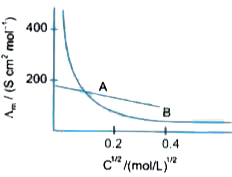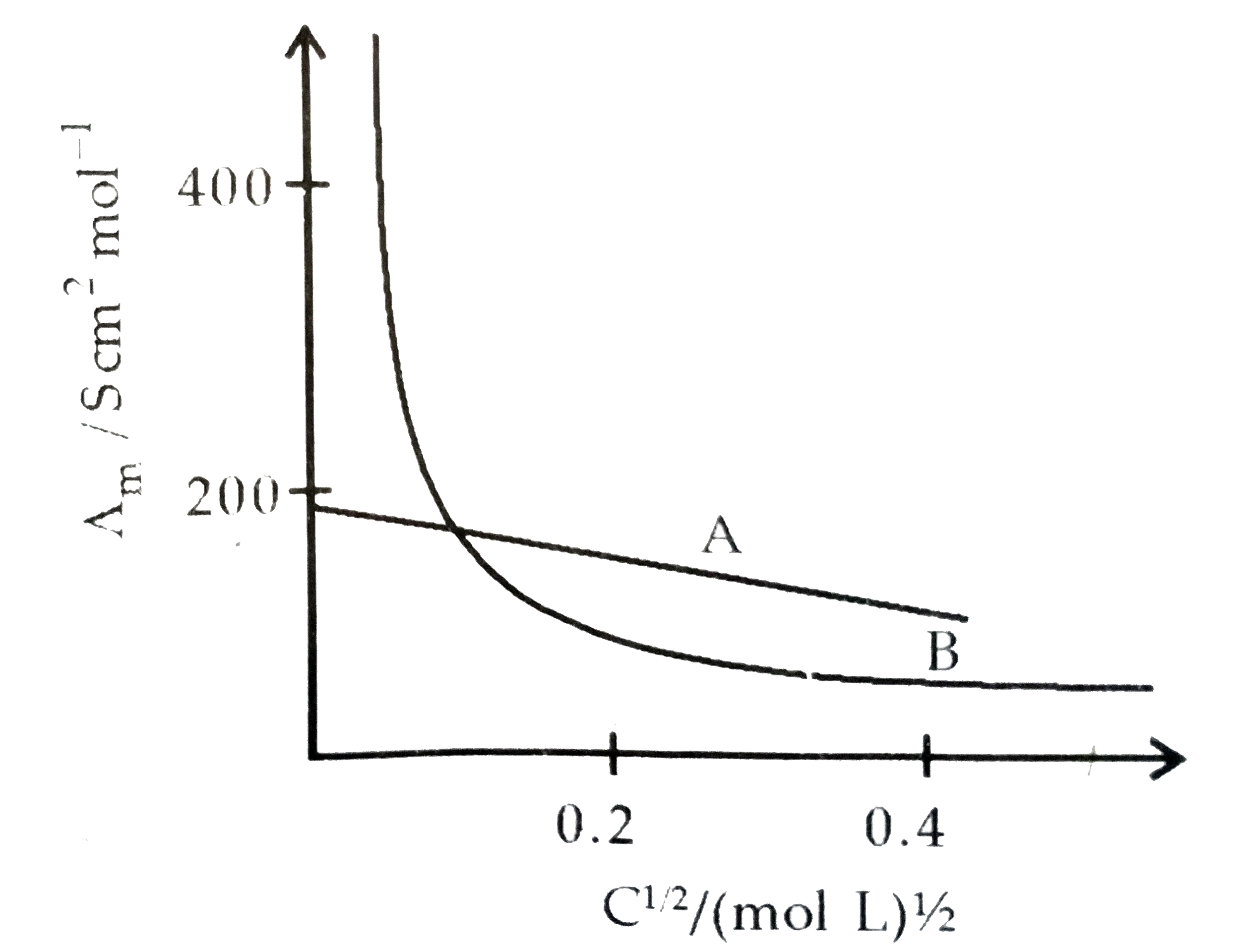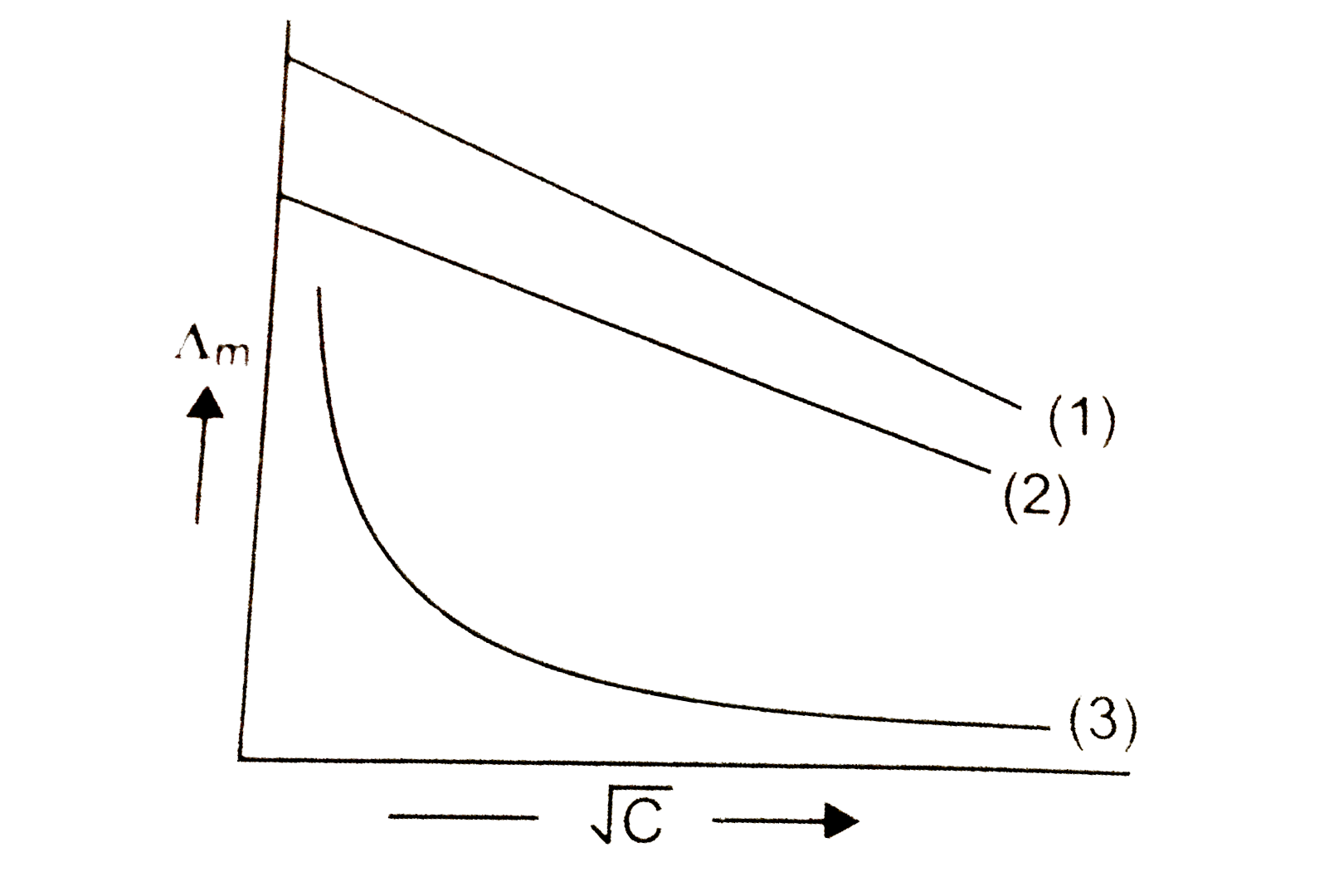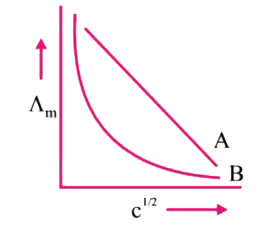The following curve is obtained when molar conductivity Λm is plotted against the square root of concentration C1/2 (x-axis) for two electrolytes A and B :
(a) What can you say about the nature of the two electrolytes A and B ?
(b) How do you account for the increase in molar conductivity A, for the electrolytes A and B on dilution ?
(a) A is a strong electrolyte whereas B is a weak electrolyte.
(b) Molar conductivity of A increases only slightly on dilution because the ionisation of A is almost complete even in concentrated solution. However, mobility of ions increases on dilution. Λm for B increases greatly on dilution because, there is increase in ionisation as well as mobility on dilution.

Topper's Solved these Questions
- ELECTROCHEMISTRY BOOK - U-LIKE SERIESCHAPTER - ELECTROCHEMISTRY EXERCISE - CASE BASED/SOURCE-BASED INTEGRATED QUESTIONS (LONG ANSWER QUESTIONS-I (3 MARKS EACH))
27 Videos
- ELECTROCHEMISTRY BOOK - U-LIKE SERIESCHAPTER - ELECTROCHEMISTRY EXERCISE - CASE BASED/SOURCE-BASED INTEGRATED QUESTIONS (LONG ANSWER QUESTIONS-II (5 MARKS EACH))
16 Videos
- ELECTROCHEMISTRY BOOK - U-LIKE SERIESCHAPTER - ELECTROCHEMISTRY EXERCISE - CASE BASED/SOURCE-BASED INTEGRATED QUESTIONS (VERY SHORT ANSWER QUESTIONS (1 MARK EACH))
47 Videos
- COORDINATION COMPOUNDSBOOK - U-LIKE SERIESCHAPTER - COORDINATION COMPOUNDSEXERCISE - SELF ASSESSMENT TEST
7 Videos
- EXAMINATION PAPER 2020BOOK - U-LIKE SERIESCHAPTER - EXAMINATION PAPER 2020EXERCISE - SECTION D
15 Videos
Similar Questions
The curves obtained when molar conductivity λm (along Y-axis) is plotted against the square root of concentration C1/2 (along X-axis) for two electrolytes 'A' and 'B' are shown.

(a) What can you say about the nature of the two electrolytes ?
(b) How do you account for the increase in molar conductivity Λm for the electrolytes A and B on dilution ?
View SolutionThe following curve is obtained when molar conductivity (∧m) is plotted against the square root of concentration, c1/2 for two electrolytes A and B
(a) How do you account for the increase in the molar conductivity of the electrolyte A on dilution.

(b) As seen from the graph, the value of limiting molar conductivity (∧0m) for electrolyte B cannot be obtained graphically. How can this value be obtained?1
View Solution
Knowledge Check
According of Kohlrausch law, the limiting value of molar conductivity of an electrolyte A2B is
Aλ∞.A++λ∞.(B−)Bλ∞.A+−λ∞.B−C2λ∞.A++12λ∞.(B−)D2λ∞.A++λ∞.B−According to Kohlrausch law, the limiting value of molar conductivity of an electrolyte, A2B is
Aλ∞(A+)+λ∞(B−)Bλ∞(A+)−λ∞(B−)C2λ∞(A+)+12λ∞(B−)D2λ∞(A+)+λ∞(B−)Molar conductance Λm is plotted against √C (mol litre−1) for three electrolytes (NaCl,HCl,NH4OH)

which of the following is correct ?AIIIIIINaClHClNH4OHBIIIIIIHClNaClNH4OHCIIIIIINH4OHNaClHClDIIIIIINH4OHHClNaCl
The following curve is obtained when molar conductivity (∧m) is plotted against the square root of concentration, c1/2 for two electrolytes A and B
(a) How do you account for the increase in the molar conductivity of the electrolyte A on dilution.

(b) As seen from the graph, the value of limiting molar conductivity (∧0m) for electrolyte B cannot be obtained graphically. How can this value be obtained?1
View SolutionIn the plot of molar conductivity (^ m) vs square root of concentration (c1/2) following curves are obtained for two electrolytes A and B :

Answer the following: (i) Predict the nature of electrolytes A and B.
(ii) What happens on extrapolation of ^ m to concentration approaching zero for electrolytes A and B?
View SolutionHow is molar conductivity related to concentration of the electrolyte ? How will you account for this variation for weak and strong electrolytes ?
View Solution(a) A steady current of 2 amperes was passed through two electrolytic cells X and Y connected in series containing electrolytes FeSO4 and ZnSO4 until 2.8 g of Fe deposited at the cathode of cell X. How long did the current flow ? Calculate the mass of Zn deposited at the cathode of cell Y
(Molar mass : Fe= 56 g mol−1 Zn-65.3g mol−1, 1F -96500 C mol−1)
(b) In the plot of molar conductivity (∧m) vs Square root of concentration (c1/2), following curves are obtained for two electrolytes.
A and B:
Answer the following : (i) Predict the nature of electrolytes A and B. (ii) What happens on extrapolation of ∧m to concentration approaching zero for electrolytes A and B ?

View Solution(a) A steady current of 2 amperes was passed through two electrolytic cells X and Y connected in series containing electrolytes FeSO4 and ZnSO4 until 2.8 g of Fe deposited at the cathode of cell X. How long did the current flow ? Calculate the mass of Zn deposited at the cathode of cell Y
(Molar mass : Fe= 56 g mol−1 Zn-65.3g mol−1, 1F -96500 C mol−1)
(b) In the plot of molar conductivity (∧m) vs Square root of concentration (c1/2), following curves are obtained for two electrolytes.
A and B:
Answer the following : (i) Predict the nature of electrolytes A and B. (ii) What happens on extrapolation of ∧m to concentration approaching zero for electrolytes A and B ?

View Solution
